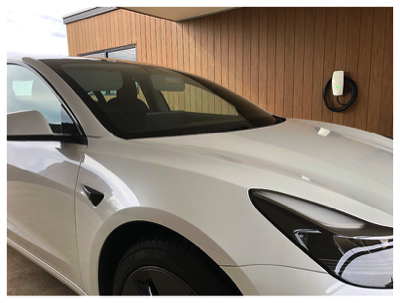Harmony House
SUSTAINABLE LIVING IN THE MODERN WORLD
ELECTRIC VEHICLE
After spending our savings on the house build, we assumed there'd be no way at all of affording an electric vehicle... When we finally crunched the numbers we were amazed to discover that we’ll be financially better off paying off a loan on an electric vehicle than sticking with our petrol car. Read further through this page for more information on our aims, research, decisions and results, as well as our tips and advice summary, for this element of our project - our electric vehicle.
OUR AIM
Quite simply, our aim was to get off petrol if we could. That was our number one motivation for looking into electric vehicles.
OUR RESEARCH
In hindsight, the most important part of my research was actually questioning the assumption that we wouldn’t be able to afford an electric vehicle. When I finally sat down to crunch the numbers (more than three years after we moved into our house, and with the intention of officially crossing the idea off my mental list) I could hardly believe what I was seeing:
It was to our financial advantage over a 7-10 year timeframe to pay off a loan on a brand new Tesla Model 3 than to stick with our old petrol car.
There were a number of factors that made this the case (some of these factors will be relevant to everyone, while some of the factors will only be relevant to those in a similar situation to us):
- A Tesla Model 3 is not a $100K-plus car like others in the Tesla line-up, but is the mid-level consumer model, selling for the same as a Hyundai Kona Electric at around $65K (this was total news to me!).
- Living in a regional area, our weekly driven kilometres (and therefore weekly petrol costs) are a bit higher than what’s usually considered average (around 400km for us most weeks).
- Interest rates on loans are at an all time low in 2021 (one of the very few plus sides to a global pandemic I guess). Even so, we still couldn’t afford most of the car loans (Hyundai, RACV, etc). But for some reason the financing options with Tesla beat all the others (a seven year loan rather than a four year loan, and with a lower interest rate too). This meant, for our situation, the weekly loan repayments came very close to our weekly petrol spend, meaning we could either put our money into petrol for the next seven years (and hence into the atmosphere), or we could put our money into an asset (the Tesla Model 3) which would continue to eliminate our petrol costs after the loan was repaid.
- Because we’ve already invested in an off-grid energy system, which generates more energy than we use, the energy we can put into an electric vehicle is free.
OUR DECISION
Even though the number crunching was very convincing (every way I looked at the numbers they showed that we’d ‘win’, regardless of my initial assumptions), it was still quite scary for us to commit to a loan. On the one hand money was tight after our build and our income has been significantly pandemic-affected… but on the other hand we had to be spending the money on petrol anyway and after 7-10 years we’d be ahead of the game financially compared to sticking with petrol (not even including a rise in petrol prices over that time)…
Despite the fear of committing to a loan, in the end there was one thought that kept bobbing to the surface and simply couldn’t be ignored:
If someone had asked us, ‘Would you swap from petrol to electric if there was no financial loss to you?’, then our answer would undoubtably be ‘yes!’ (in fact, I’m sure we would also have considered accepting some financial loss to avoid contributing to pollution). So when the situation becomes, ‘Would you swap from petrol to electric if there was also a financial gain for you?’, how can the answer be no? It couldn’t.
THE INSTALLATION
Tesla is a very professional company, as you’d expect, and the purchasing/financing process was very smooth indeed. It wasn’t much more than four weeks from sitting down to my initial number crunching (“I don’t believe we can afford an electric vehicle”), to actually looking at my Tesla Model 3 in the carport charging from our solar panels (“I don’t believe I’m looking at my very own Tesla Model 3 in the carport charging from our solar panels”).

OUR THOUGHTS ON COMPLETION
We were quite astounded (and still are actually) that the weekly loan repayments were close enough to our weekly petrol spend to make owning an electric vehicle not only affordable right away, but also the only sensible financial decision in the medium to long term (seven years plus). It shows how far electric vehicles have come in the last few years. And judging from recent developments in laws and policies in Europe and the US, this is really just the beginning.
OUR EXPERIENCE SO FAR
It feels amazing to be driving on ‘sunlight’. It really does. The fact that we’re not creating any emissions in our hundreds of weekly kilometres is a big deal for us personally, in our efforts to live sustainably and by our principles. The emission-free nature of our driving also goes a long way toward curbing the embarrassment we still feel owning and driving a brand new car (something neither of us have done in our lives).
We are very happy with our choice of EV too. Not only the great look, design and features of the Tesla Model 3, but also the fact that our car will receive wireless software updates for its entire life (whether we own it, or a new owner down the track). So the software features of our car should match new Teslas being released for years to come. To me this goes a long way to proving the core environmental principles at work in the Tesla company: no “designed obsolescence” here, but rather the opposite - “deliberate relevance” perhaps? Certainly a very welcome feeling that care and attention is being given to the life-cycle of their products.
Charging our EV on our off-grid energy system has been quite manageable, though thought and planning each week has definitely been needed, together with a good understanding of how our off-grid system works and how to get the most out of it. Whereas managing EV charging on a normal grid connected system is quite easy - simply plugging in overnight when the vehicle isn’t being used, and waking to a fully charged vehicle each morning - in an off-grid situation the best daylight charging opportunities are often the same times the vehicle may be in use, hence the need for planning and energy management. I have found ways to very effectively give our vehicle as much energy as possible without denying our house batteries the recharging they need each day. (If you’re in an off-grid situation and planning an EV purchase, feel free to contact me for more details on our charging regime, and how it might apply to your particular off-grid system.) As with other aspects of our off-grid energy management, this process has served to give me a healthy respect for the amount of energy we use in our lives, and in this case how much in particular is needed for transportation. It’s increased my understanding of how energy-dense fossil fuels are, and hence how they’ve become so integral to the functioning of society. It’s great to now have options to start weaning ourselves off them.
While on the subject of charging, it’s worth noting that the amount of charging you’ll need to do doesn’t have anything to do with the battery size of your EV, but rather the amount of kilometres you drive each week (i.e. how much of the battery charge you’ll use each week and need to replace). And this leads us to the important fact that EV range claims and how they’re calculated will be different to real world kilometre range. For a start, there are different range tests that automakers can use, with the European WLTP efficiency standard being significantly more accurate than the decades-old NEDC test - in fact you can safely ignore any NEDC range estimates as often being wildly inaccurate in real world driving scenarios. The WLTP range estimates come much closer to real world driving: I find that in optimal driving conditions (not using headlights, windscreen wipers, or cabin climate control, and in warmish weather where the EV’s ) my Tesla Model 3 can get 90% of the WLTP range claim, but in circumstances where accessories are using extra energy (as is the case with headlights, windscreen wipers, and cabin climate control to name some features) then expecting to achieve about 80% of the WLTP range claim is a much safer estimate. Keep in mind also that you’ll never want to actually run out of charge, as this has the potential to sometimes damage some components, so aiming never to drop below 5-10% battery charge is probably a good idea. All these factors are important when researching your EV choice, to match the vehicle’s capabilities to your driving needs and expected charging regime.
OUR TIPS AND ADVICE SUMMARY
- Don't assume an EV isn't affordable, but instead crunch the numbers to find out for sure one way or another. Key factors that will affect how the numbers fall for you are: how many kilometres you drive each week, where your electricity comes from (solar generated or grid purchased), and whether you’re subject to the Victorian ‘ZLEV road-user charge’ or not (not necessarily a death knell depending on the other factors, but will certainly have a negative impact on your number crunching which isn’t great for EV take-up in Victoria).
- Research your EV choice carefully, to match the vehicle’s capabilities to your driving needs and expected charging regime. This includes knowing how many kilometres you are likely to drive each week, and what your at-home charging regime is likely to be. When reading range estimates of different vehicles, ignore any NEDC range estimates, and work to 80-90% of WLTP range estimates while aiming to keep a minimum of 5-10% battery charge to be on the safe side. Doing your calculations within these margins will help ensure you end up with the right vehicle and not experience any disappointment.
- We are extremely happy with the Tesla Model 3. With great design and features, it’s a fantastic quality product that we felt represented great value for money compared to its competitors.
- If you’re in an off-grid situation, feel free to contact me for more detailed advice on EV charge management within the bounds of your off-grid energy system.
